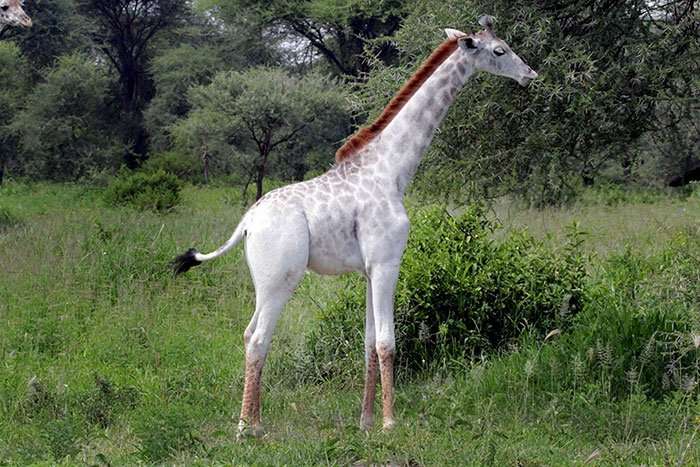A stunning Dr Derek Lee, founder and scientist at the Wild Nature Institute of Tanzania, was the first one who spotted this white giraffe called then Omo, in Tarangire National Park in 2015.
“Omo appears to get along with the other giraffes, she has always been seen with a large group of normally coloured giraffe – they don’t seem to mind her different colouring,” he explained.
“We and our partners are working on giraffe conservation and anti-poaching to help give Omo and her relatives a better chance of survival. We hope that she lives a long life and that some day she has calves of her own.”.



What is leucism?
Leucism inhibits pigmentation in some skin cells;
It is different to albinism where no melanin is produced at all;
Animals with leucism may have darker pigment in their soft tissue;
Giraffes with leucism retain their dark eyes, whereas animals with albinism have red eyes;
Birds, lions, fish, peacocks, penguins, eagles, hippos, zebras, monkeys and snakes have all displayed traits of leucism.

But Omo is not the only living exemplar of white giraffe. Untill March 2020 there were other White giraffes in Kenya, in Ishaqbini Hirola Community Conservancy, but rangers had found the carcasses of the female and her calf in a village in north-eastern Kenya’s Garissa County.
A third white giraffe is still alive.
The mother and her calf were found in a “skeletal state”, and were thought to have died at least four months ago, Ishaqbini Hirola Conservancy said in a twitter statement.
SAD NEWS
?
: @IshaqbiniHirola
Community Conservancy, Garissa County loses two famous white giraffes to poachers.
For more info, here’s the press release.
@KWS
@USAIDKenya
@EUinKenya
@denmarkinkenya
@Nature_Africa
@KWCAKenya
@africa_ci
@SwedeninKE
The rare giraffes had been living at the Kenyan wildlife sanctuary. The Kenya Wildlife Service was called to investigate the disappearance after the animals had been seen for several weeks.
“This is a very sad day for the community of Ijara and Kenya as a whole. We are the only community in the world who are custodians of the white giraffes,” Mohammed Ahmednoor, manager of the reserve in Garissa County, Kenya, said in a press release.

The reasons for the massacre of the two white giraffes, whose remains were found in Ijara, have yet to be determined, as well as the perpetrators. The Kenya Wildlife Society, the country’s leading conservation organisation, recently stated that it was investigating the killings. Giraffe hunting is illegal in Kenya but the world’s slenderest mammals are still poached for their skin, meat, bones and tails. In Laikipia, in central Kenya, the Samburu community is used to eating them. According to them, killing one giraffe can feed an entire family for a week.
African Wildlife Foundation alerts that about 40 percent of the giraffe population has disappeared in the last 30 years due to poaching. Across Africa, the giraffe population has declined from about 155,000 in 1985 to 97,000 in 2015, according to the International Union for Conservation of Nature (IUCN).













